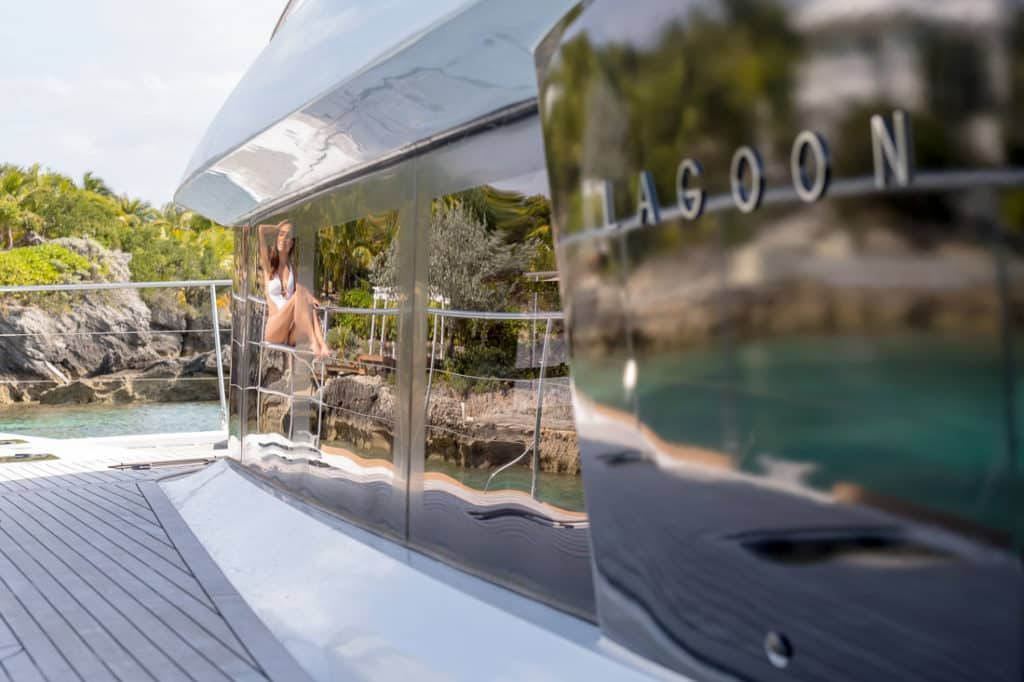
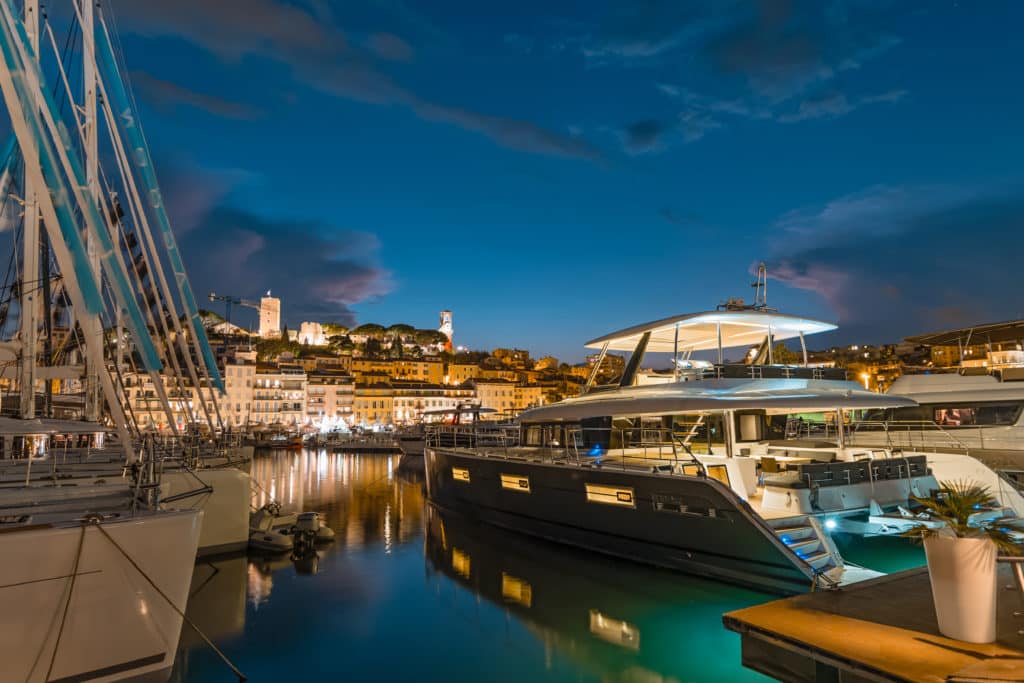
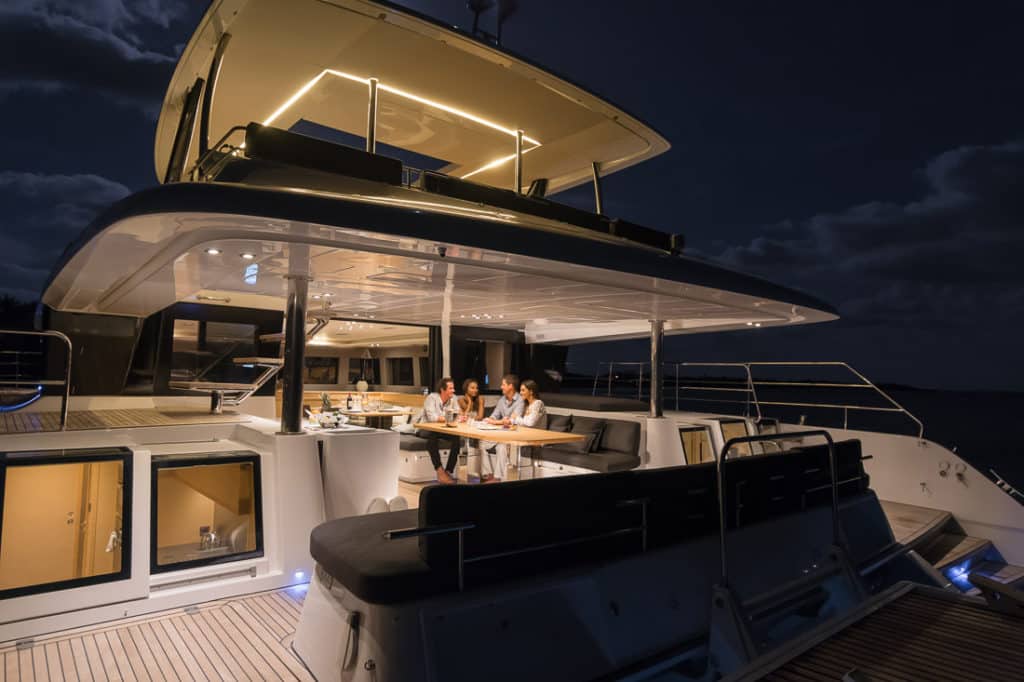
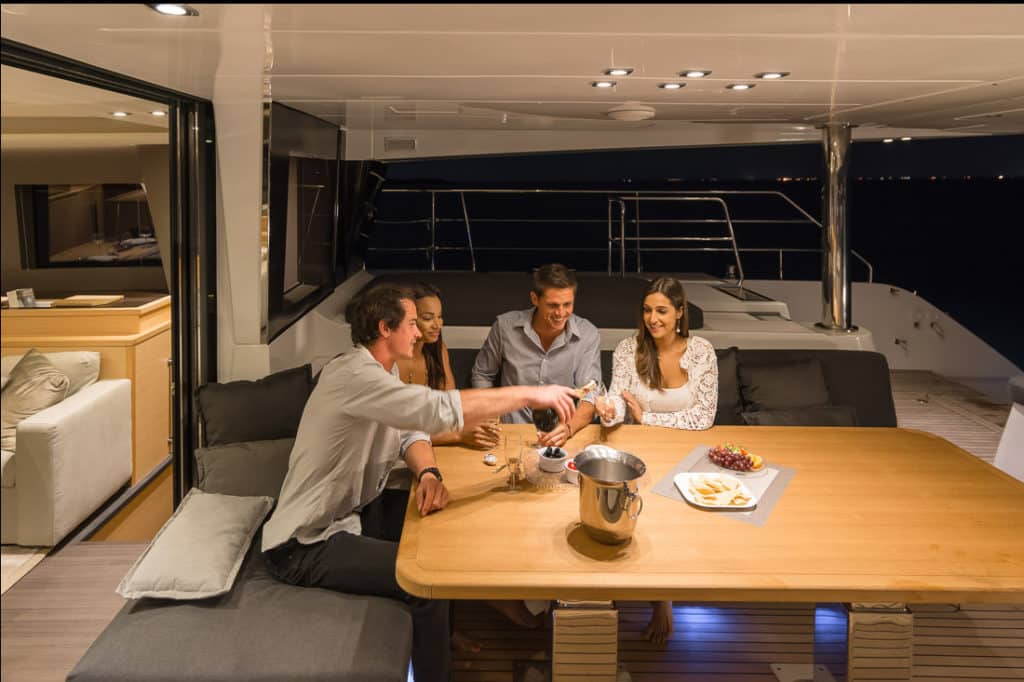
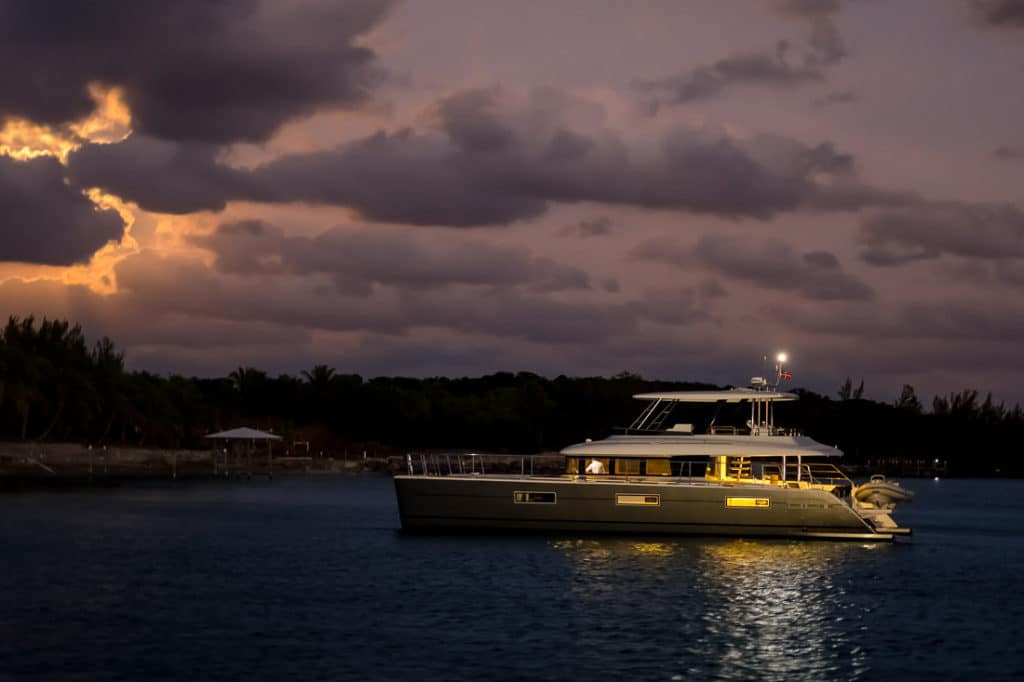
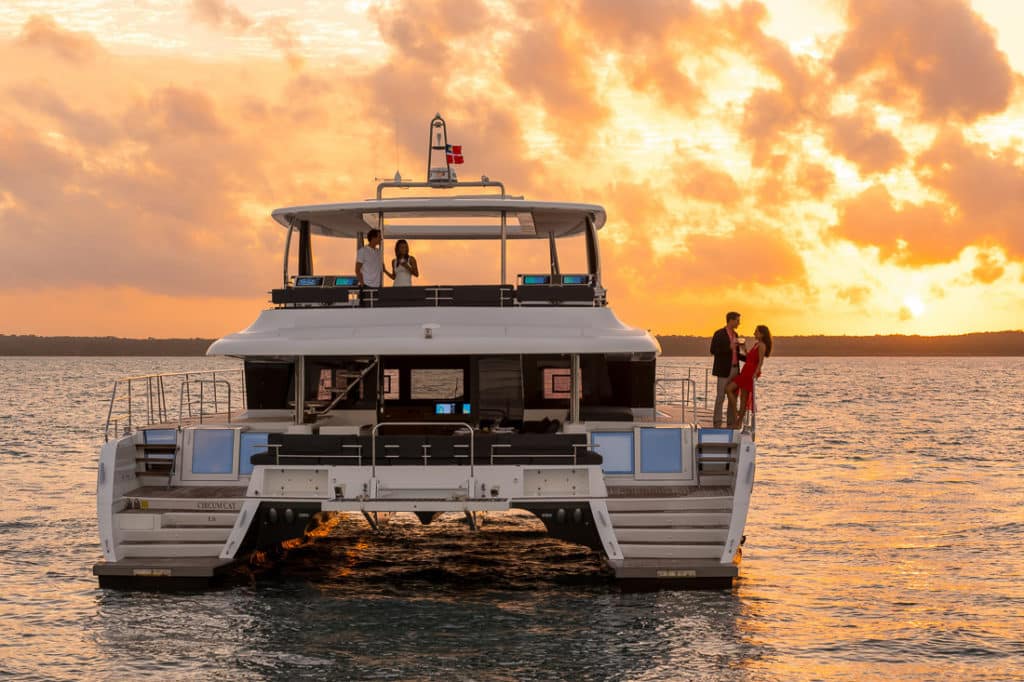
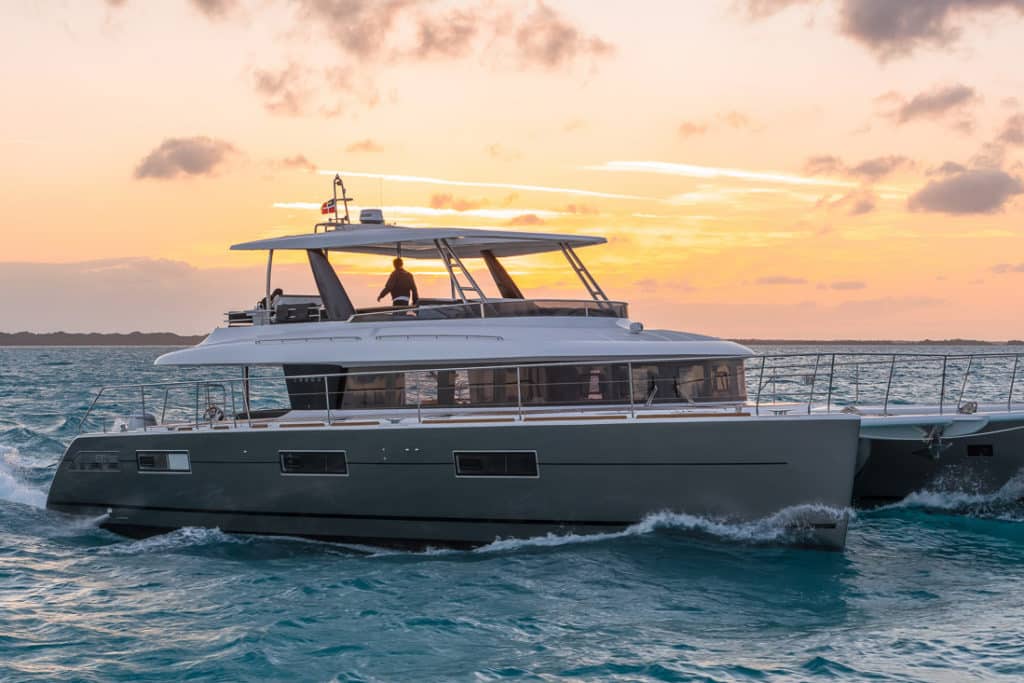
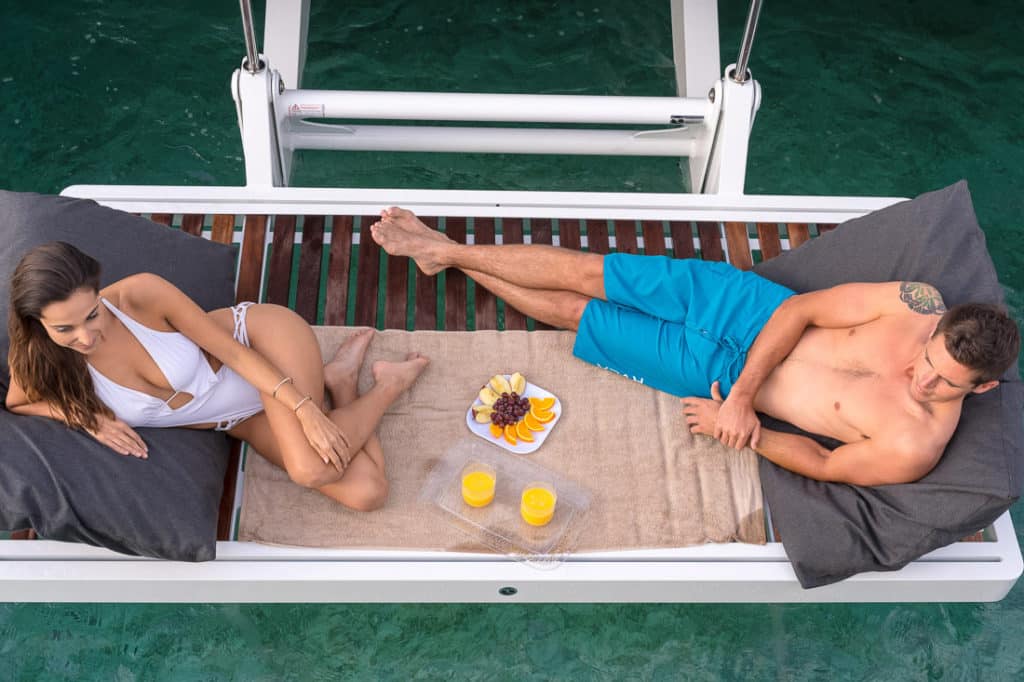
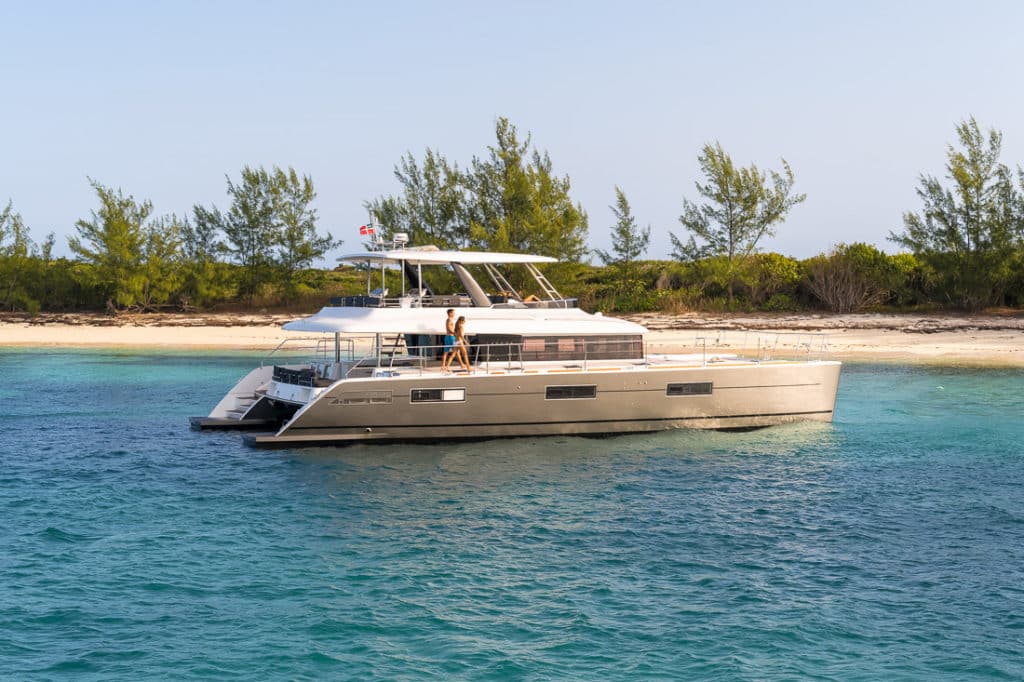
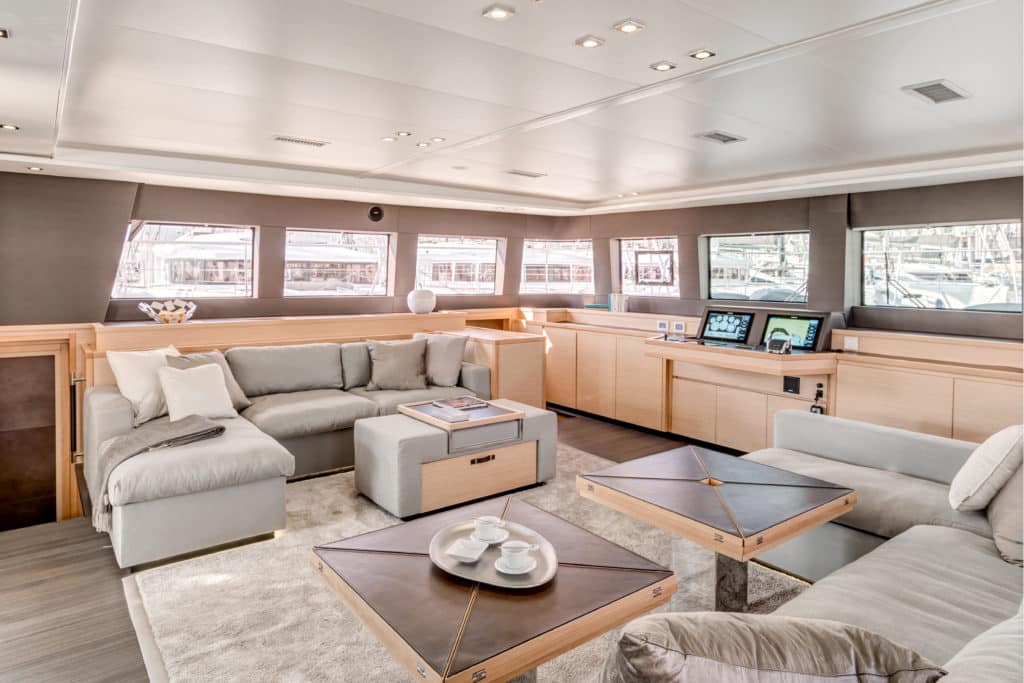
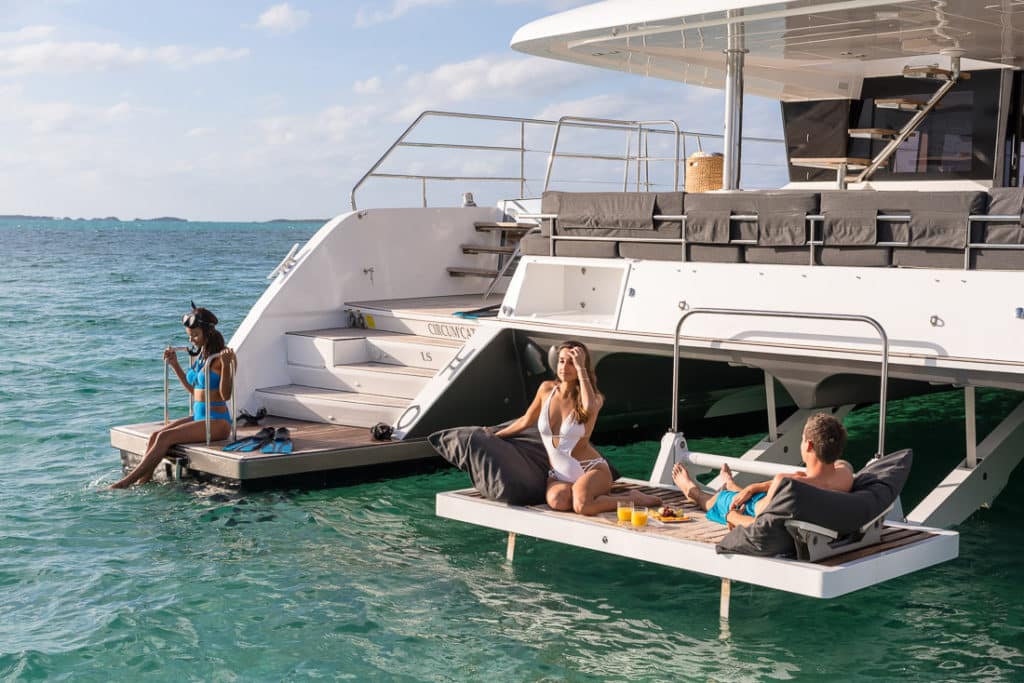
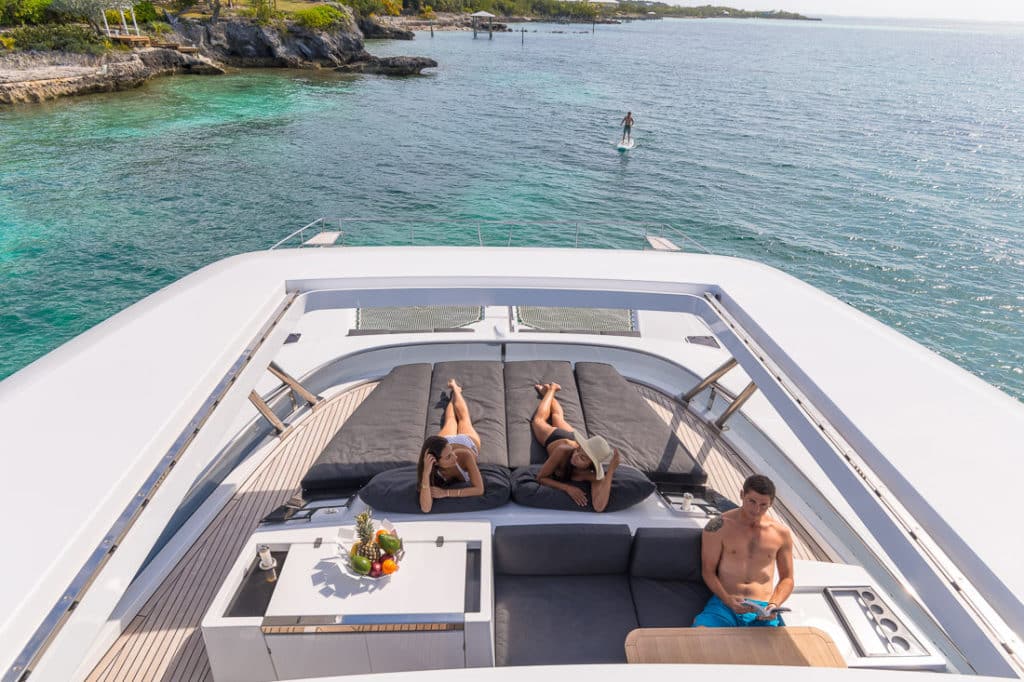
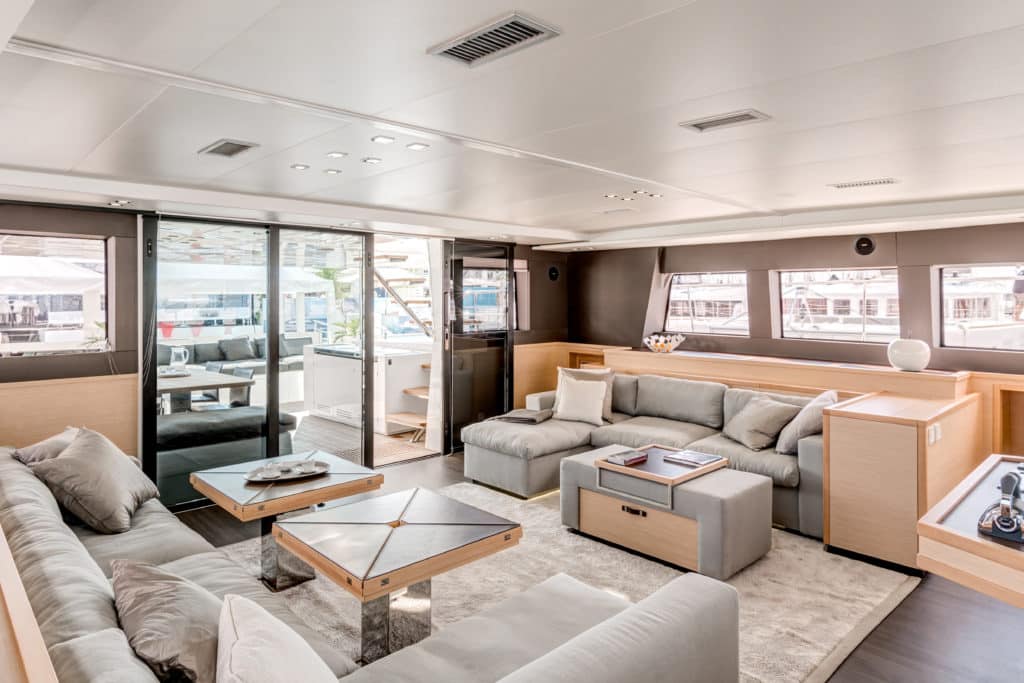
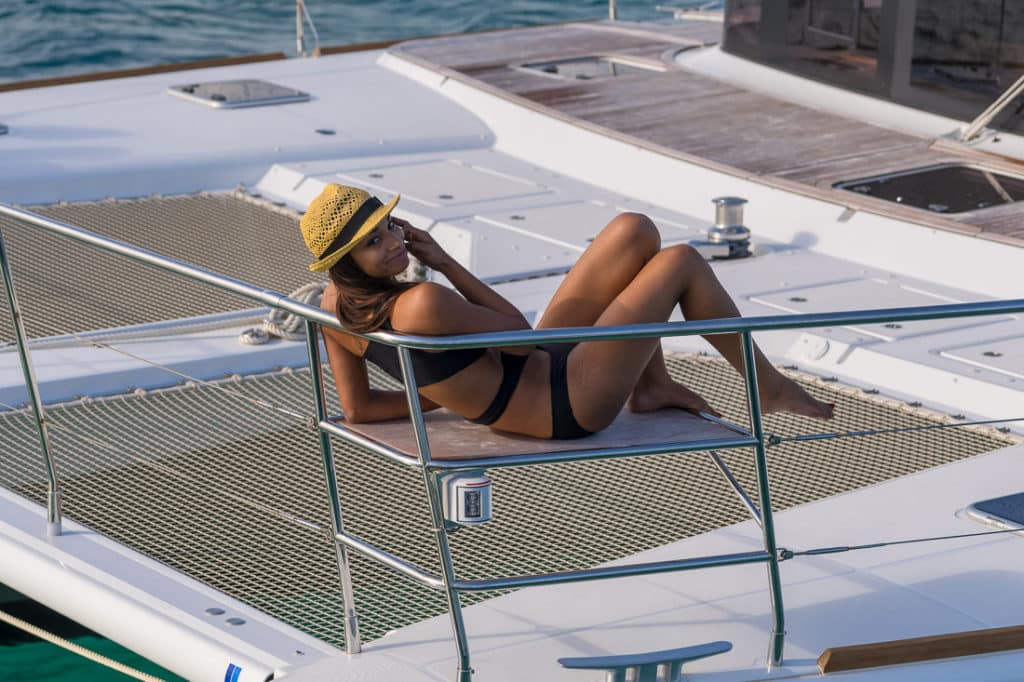
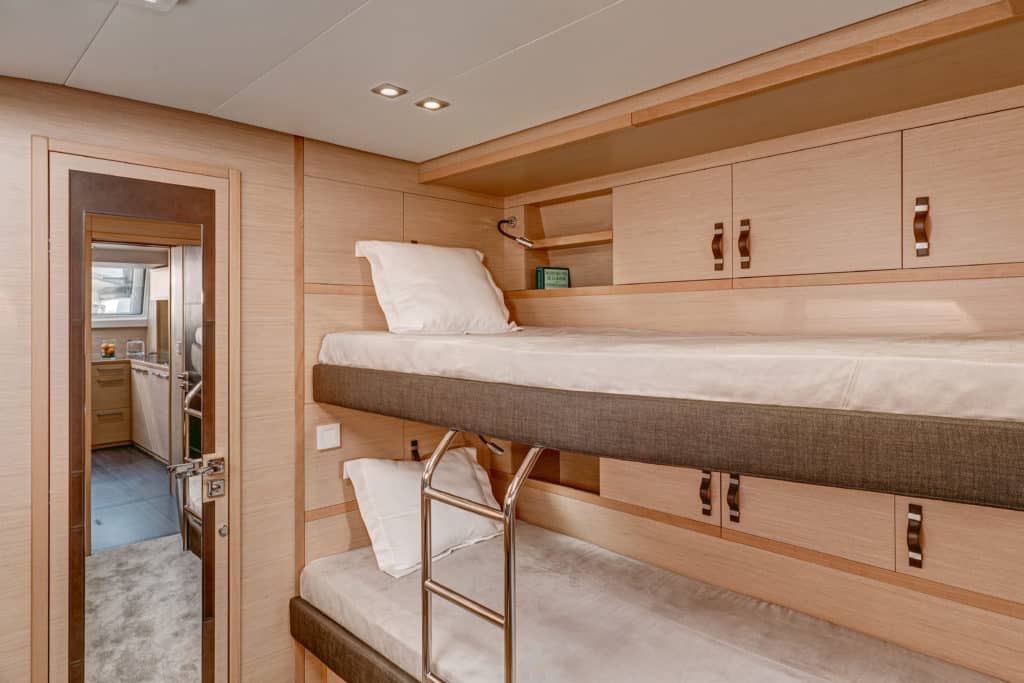
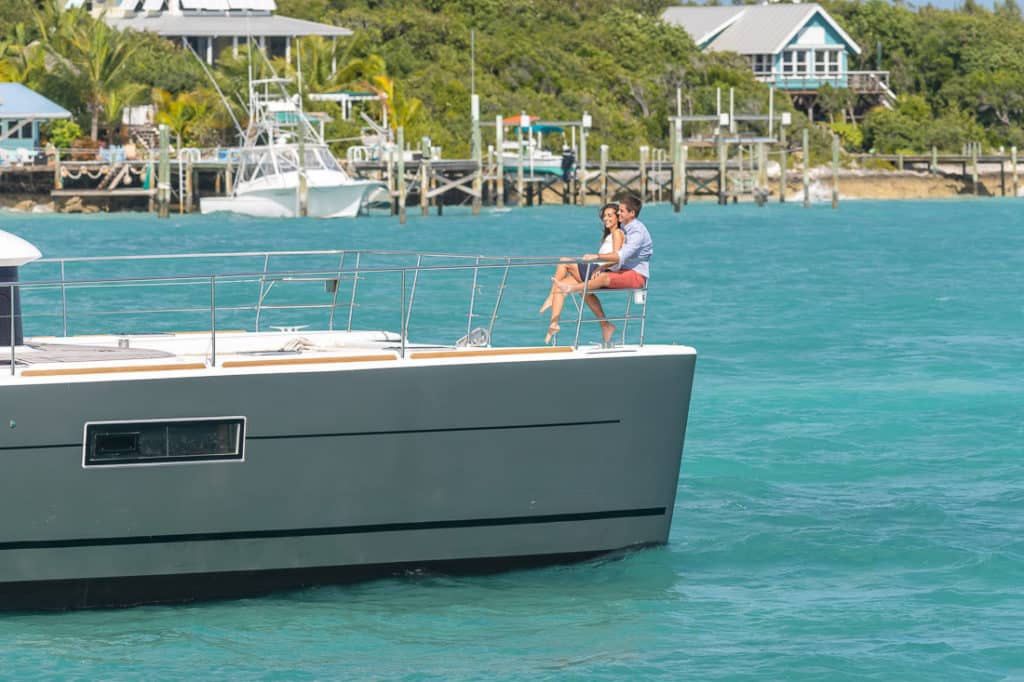
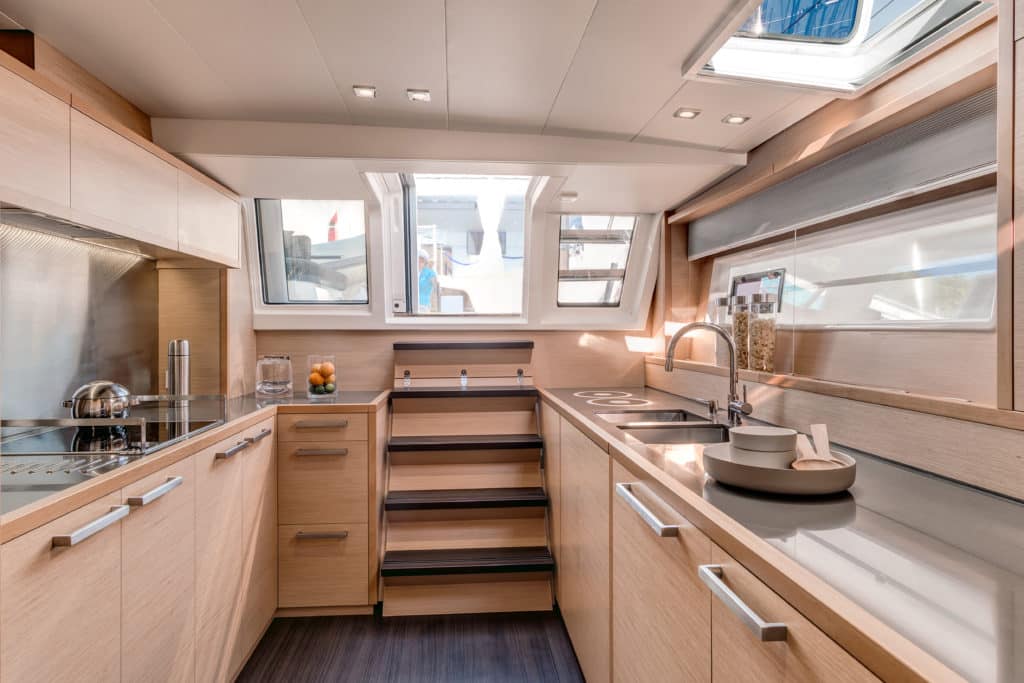
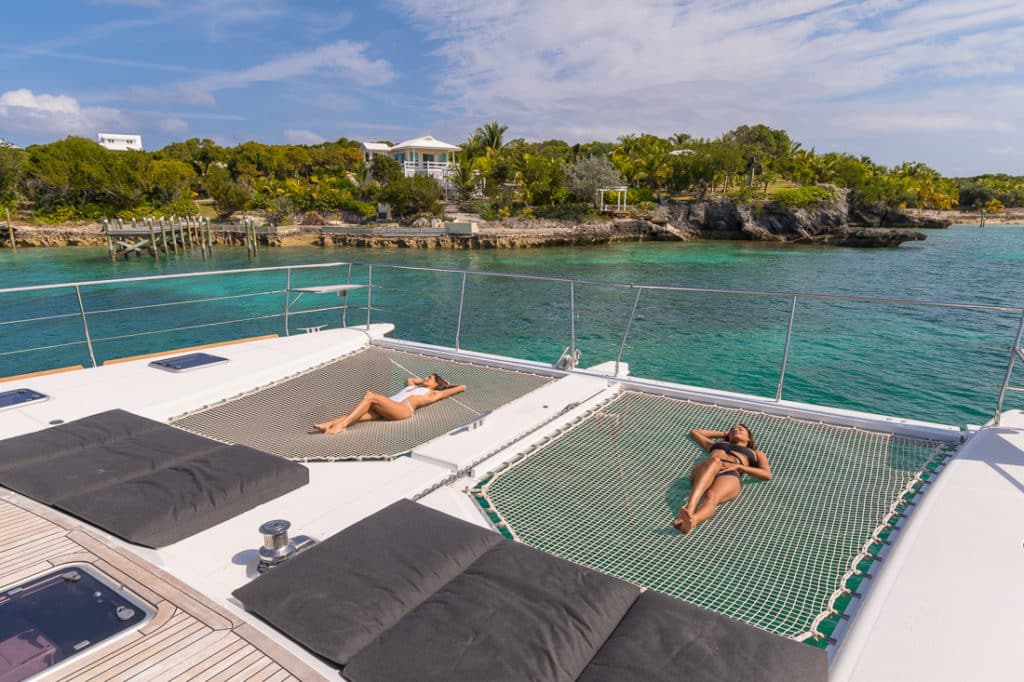
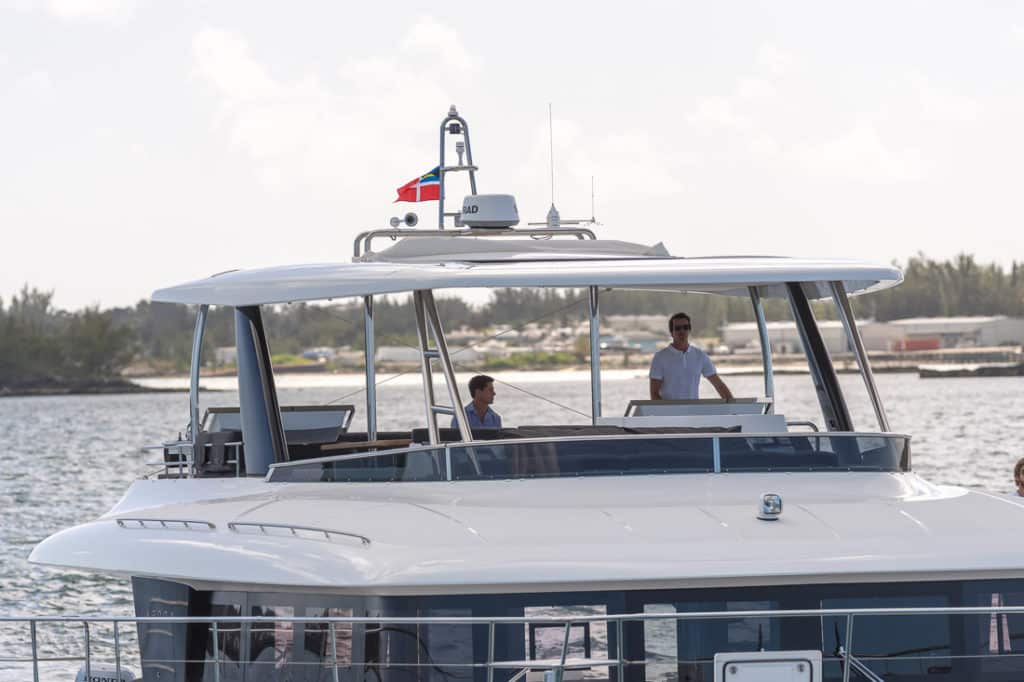
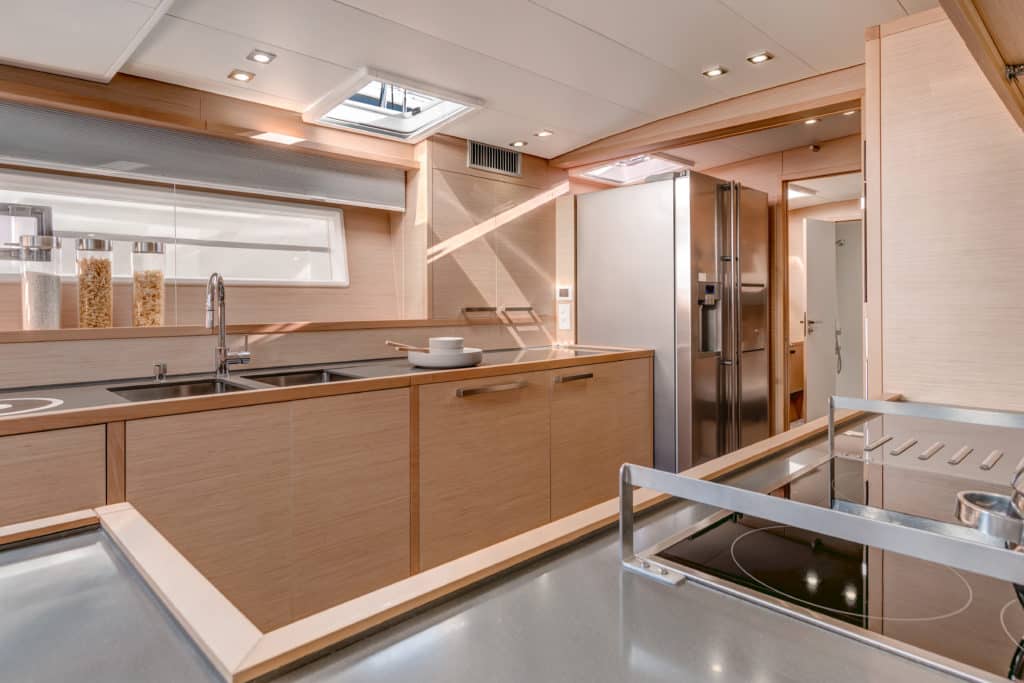
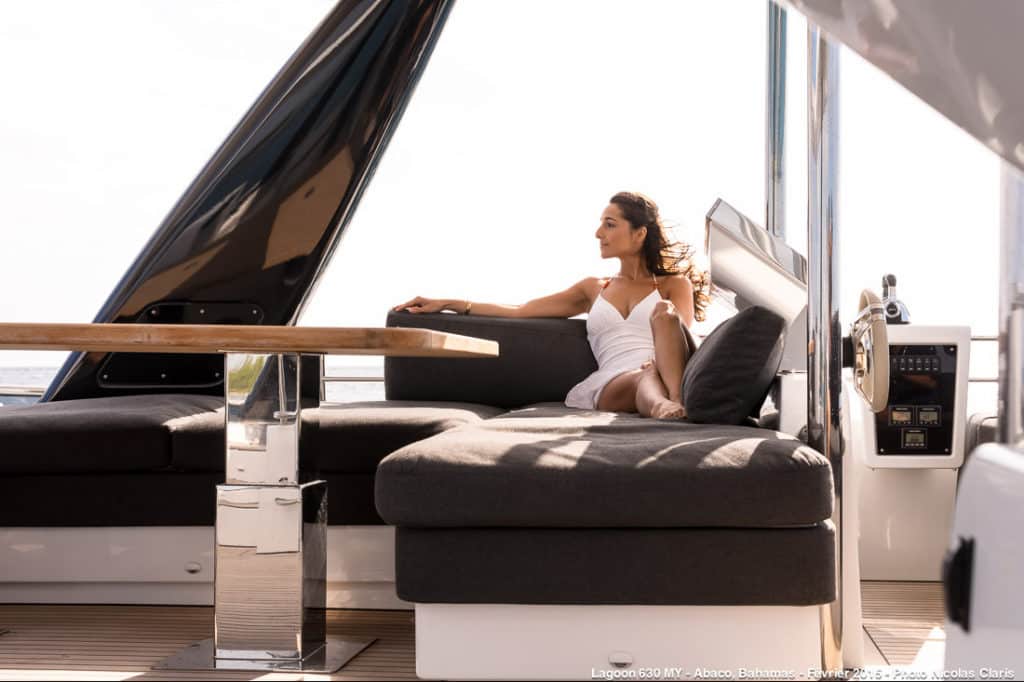
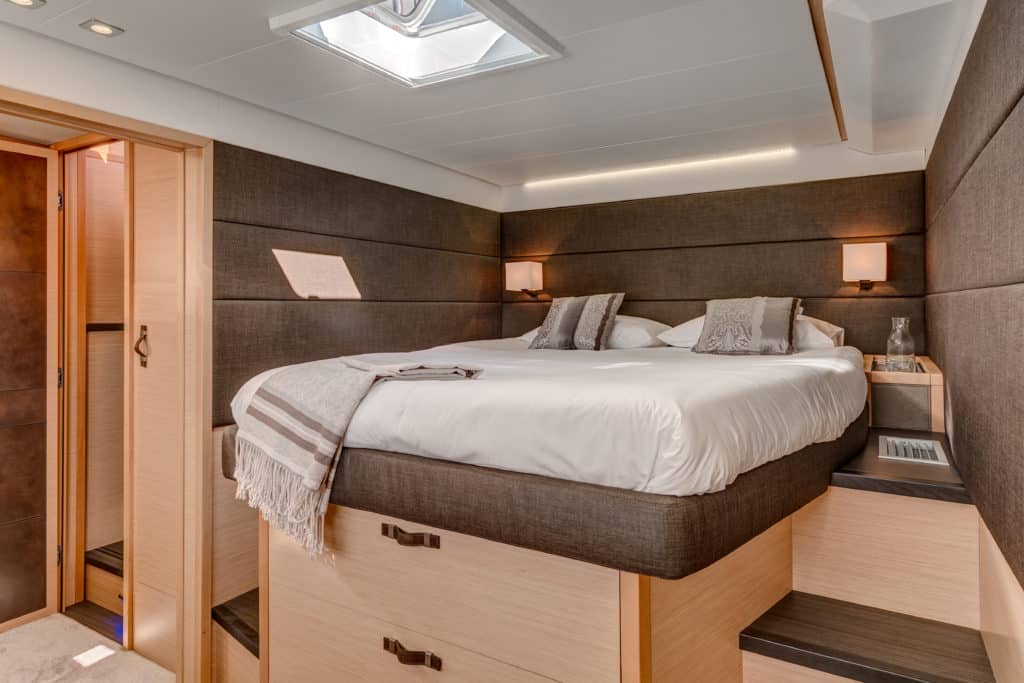
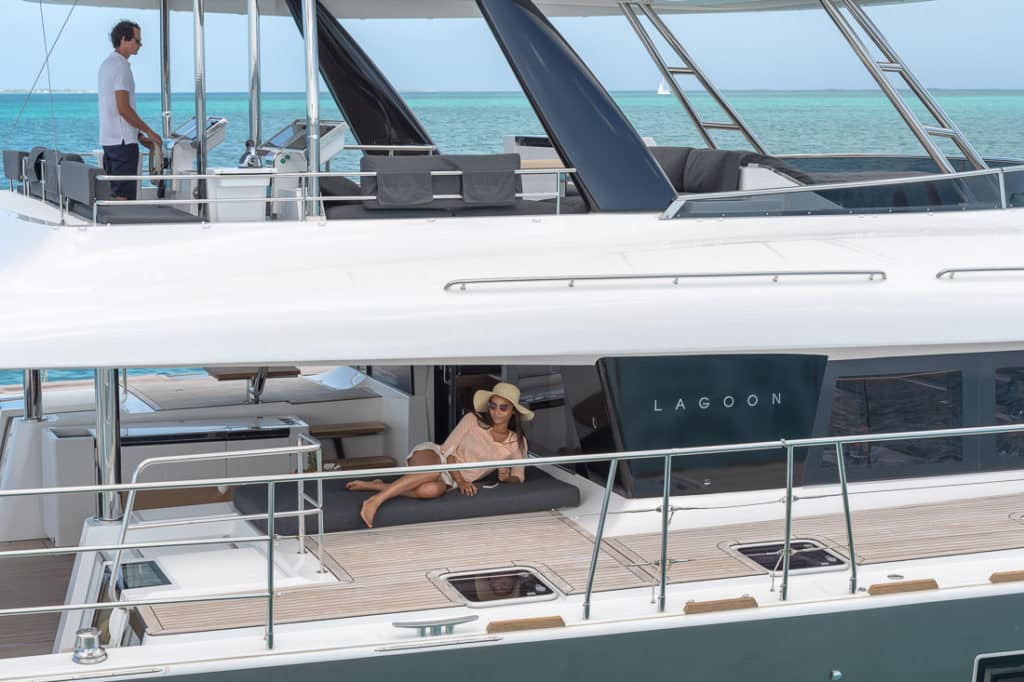
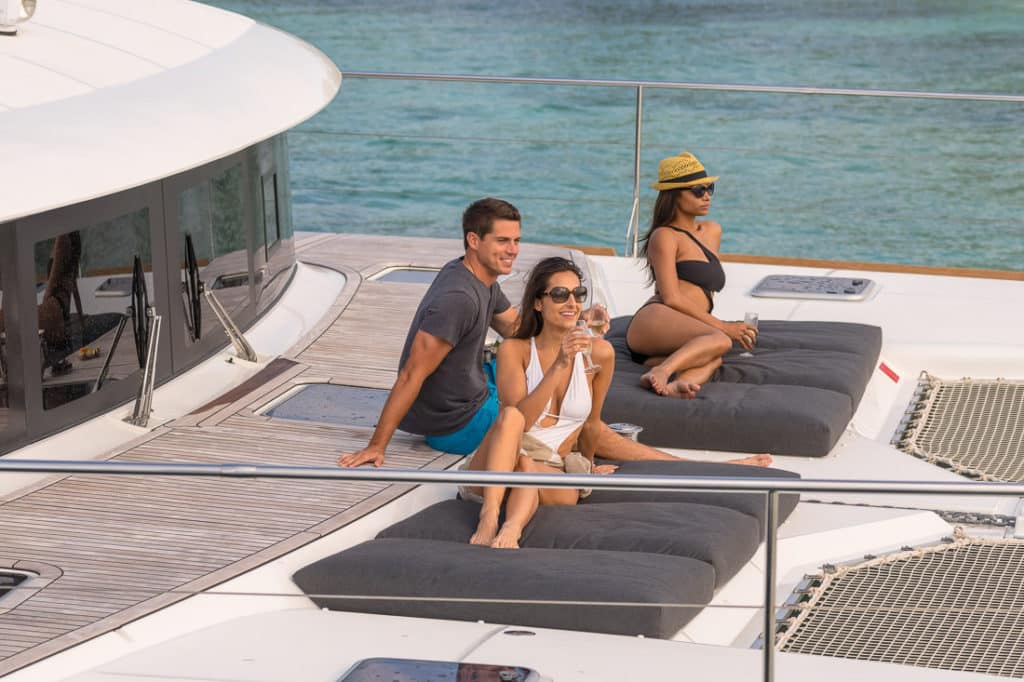
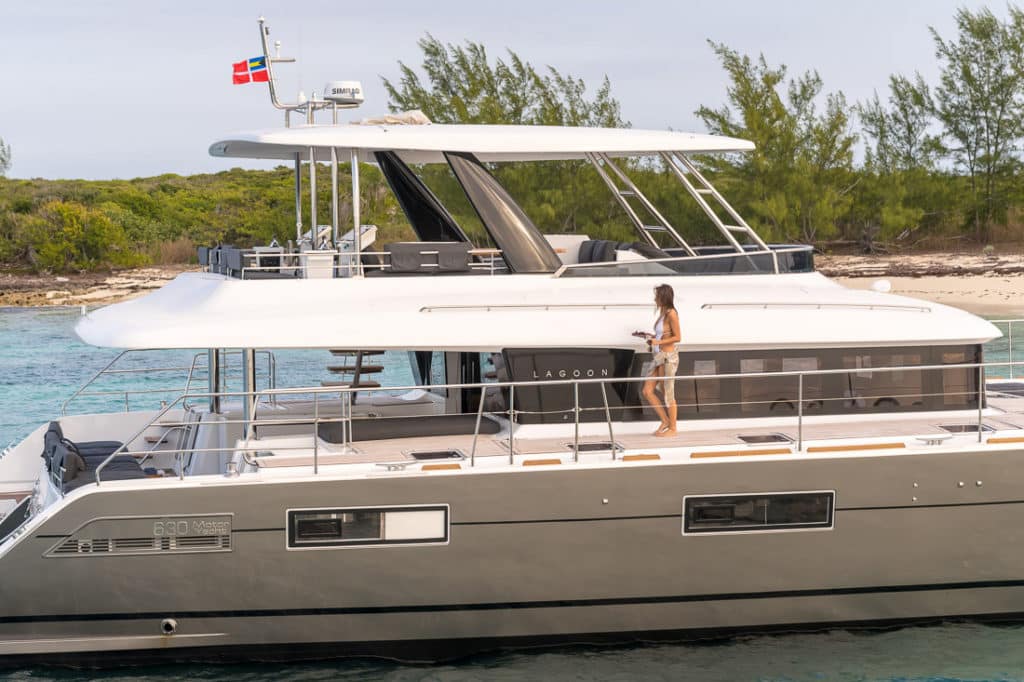
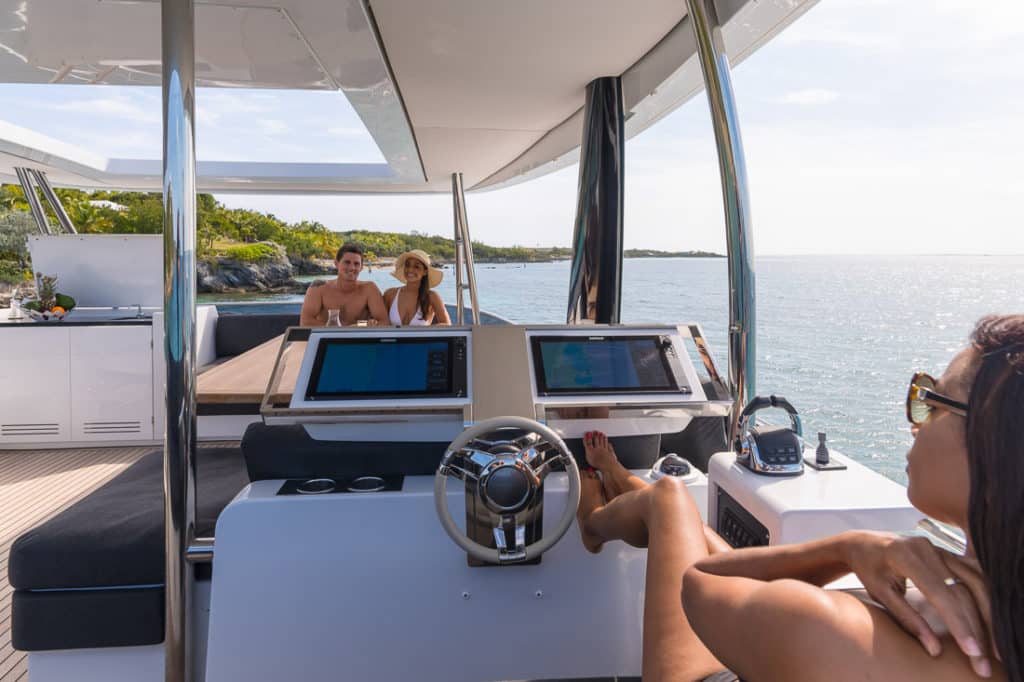
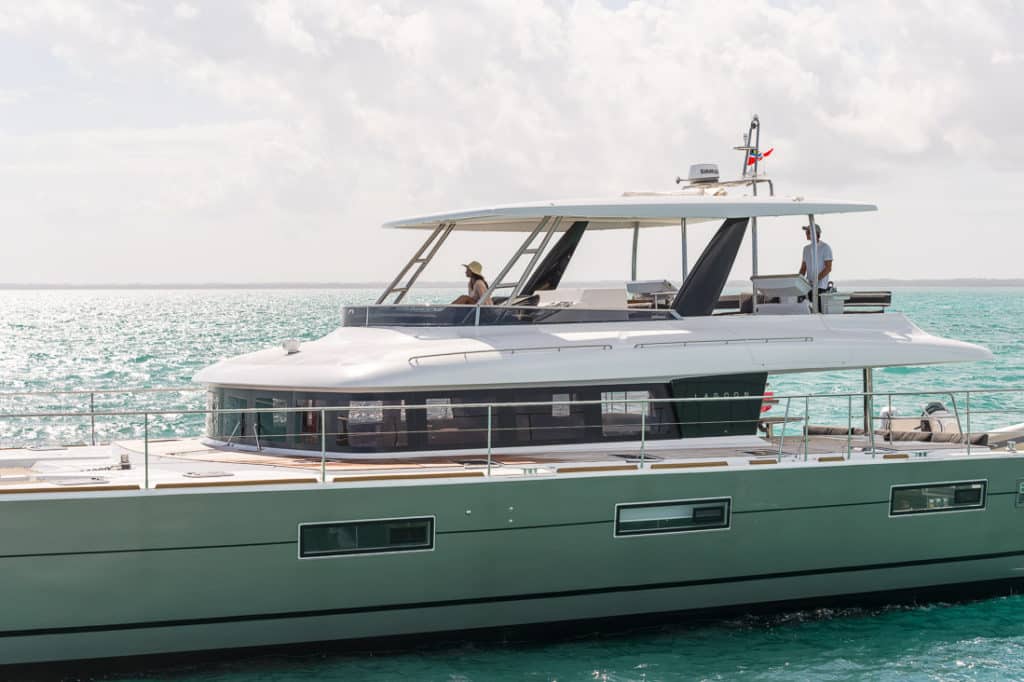
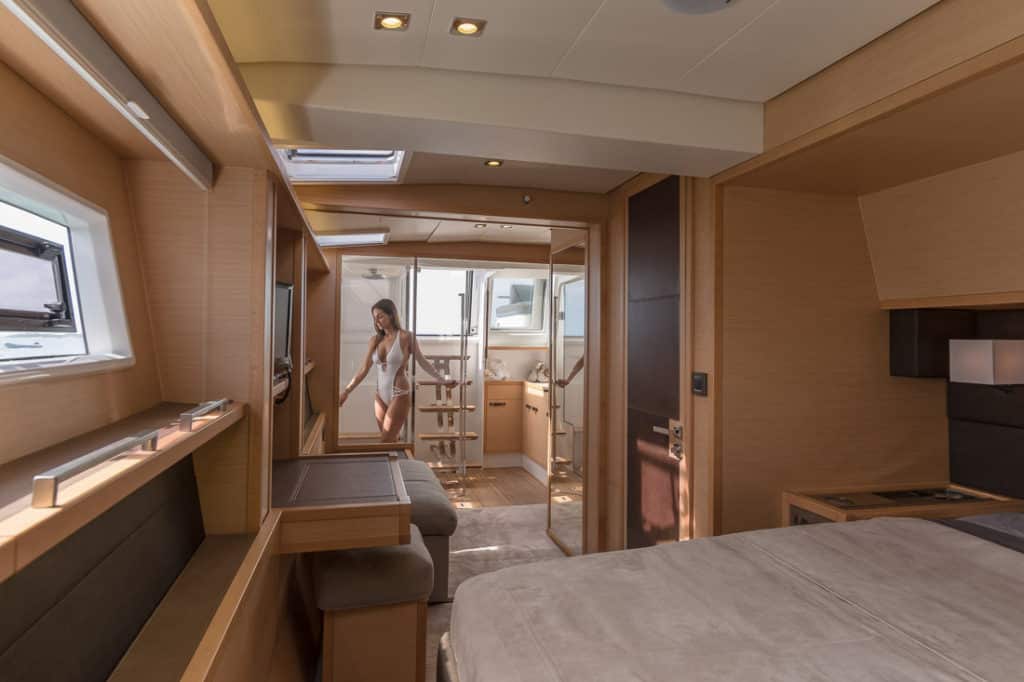
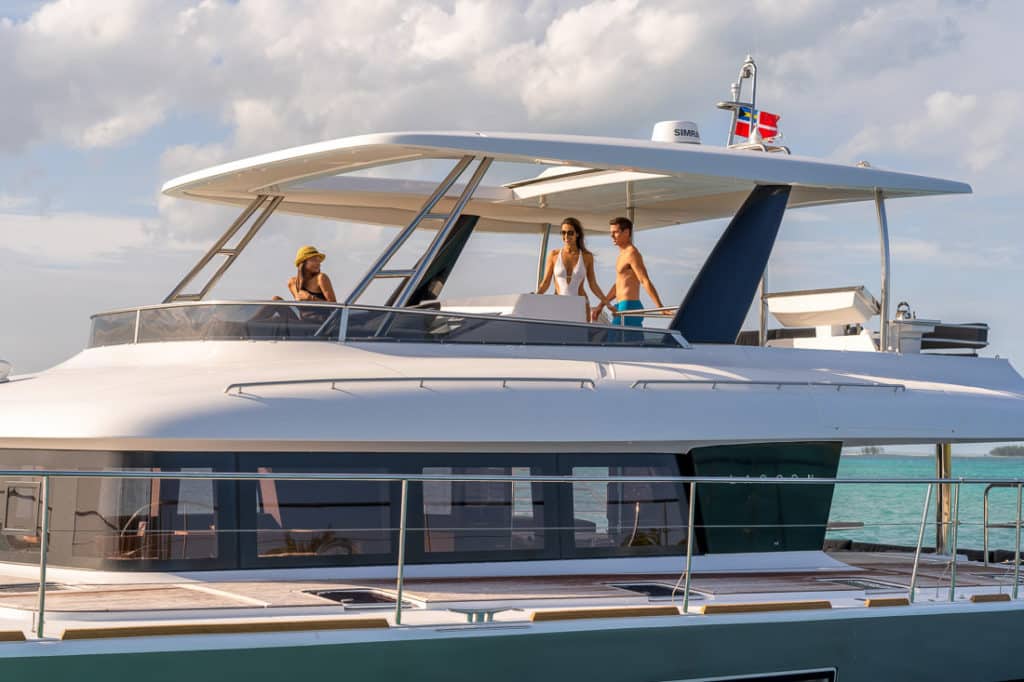
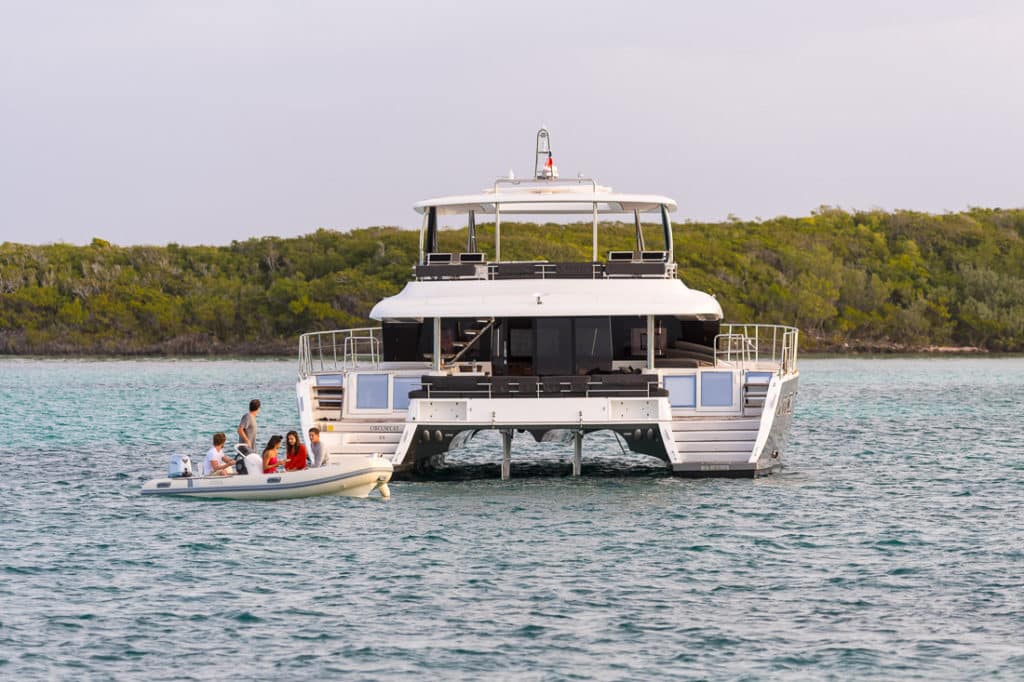
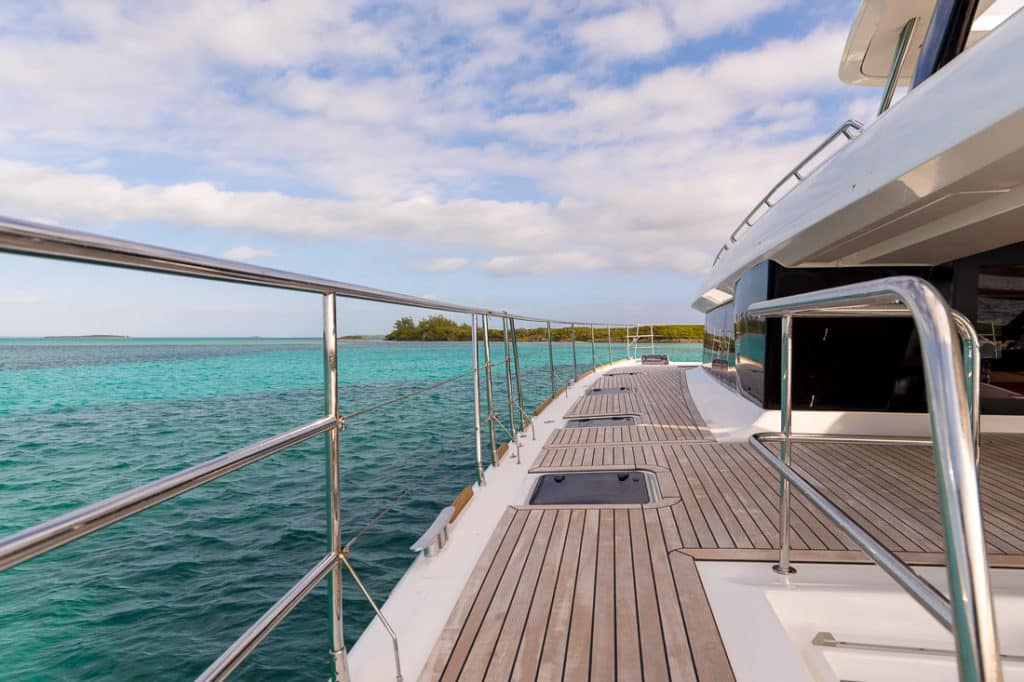
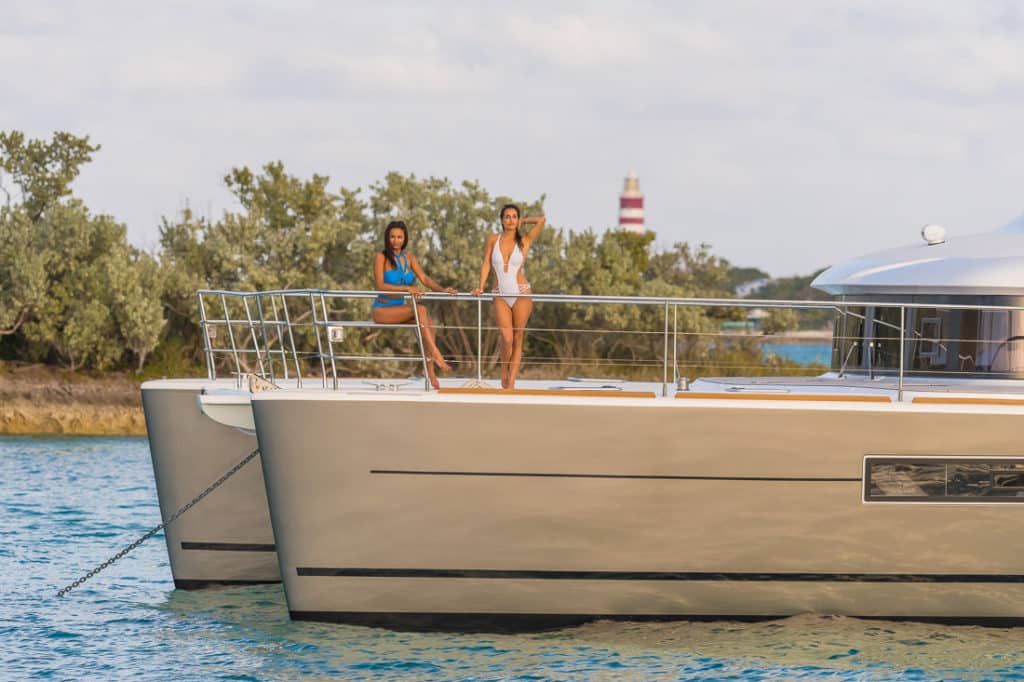
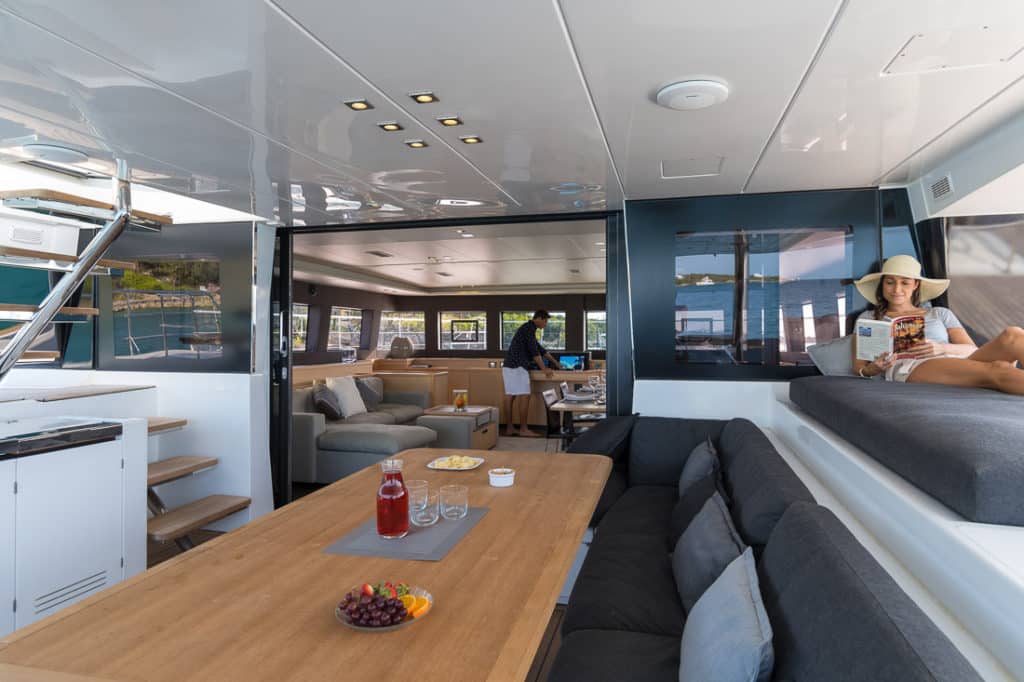
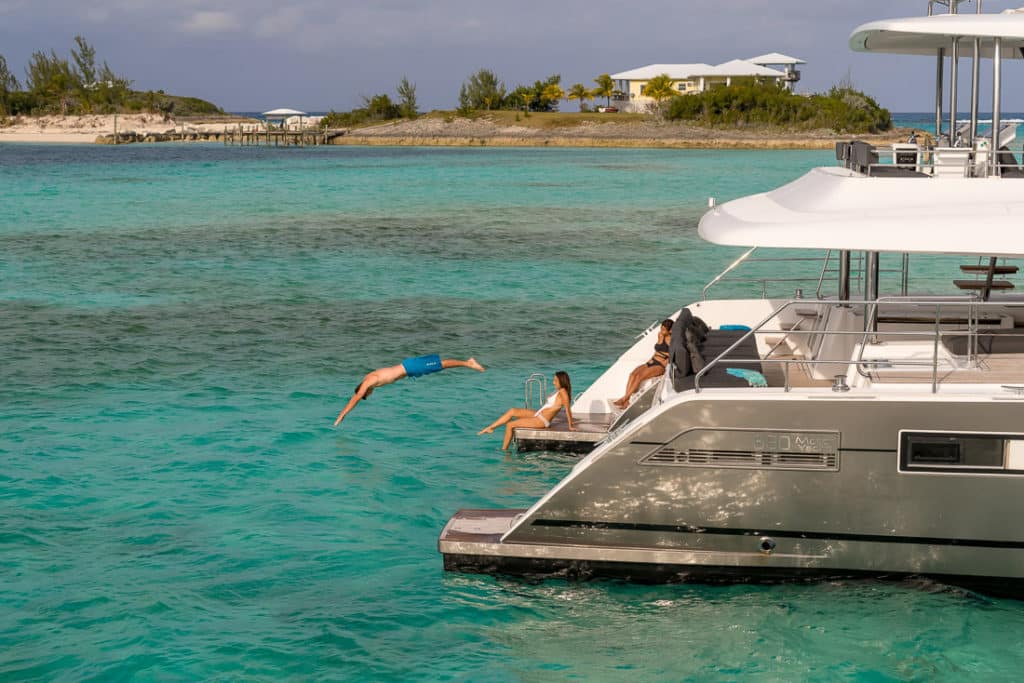
A quick glance aft confirmed what we were all expecting. Strong northerly winds of 25 knots, gusting to 30 knots, had whipped the Gulf Stream into a wild washboard of 6- to 8-foot waves, every other one cresting into a white foamy top that approached the stern of our Lagoon Yachts’ 630 Motor Yacht with a growling sound that cut through the rise and fall of the wailing breeze.
I watched from my perch on the aft deck as a tall wave rolled up behind us, ducked under our yacht’s hulls and lifted them briefly, and then I felt the acceleration as the 630 MY surfed down the face. Looking through the salon to the screen at the interior helm, I saw the speed pick up to 14 knots, then slow to our original 10 knots as the wave passed. It was a thrilling ride, never out of control, and very predictable as the autopilot once again found our original course. The 32-foot beam kept the sole squarely under my Top-Siders, and I marveled at the roll resistance of her twin hulls.
I was surprised at how well the power catamaran performed in these conditions, but really, I shouldn’t have been. The 630 MY is based on the Lagoon 620 sailing catamaran and, with more than 50 620s built, is a tried-and-true platform for open-ocean cruising.
For those skeptical that a sailing catamaran hull can perform as well as a designed-from-scratch power cat, I should tell you that the last 20 percent or so of the hulls’ underbody was redesigned by Marc Van Peteghem and Vincent Lauriot-Prevost along with the engineers at Lagoon to provide support for two larger (than you’ll find in the sailing version) Volvo Penta D4 diesels with V-drives turning 24-by-21-inch, fixed four-blade props.
The finished product achieves a running angle of just a few degrees of lift in the bow for a perfect running angle in all kinds of sea conditions. Short keels in the center of the boat are deep enough to protect the running gear should you decide to beach the boat and explore. Spaced wide apart, the engines give out standing handling in close quarters, but Lagoon also specified an electrical bow thruster in the starboard hull for added maneuverability.
We were delivering the 630 MY from Marsh Harbour in the Abacos to Miami over a period of three days, and had left that delightful Bahamian destination the day before, hoping to make Freeport before nightfall. As luck would have it, the leading edge of the front swept in well before we could make it there, so instead of trying to navigate the tricky Freeport approach in the dark, we altered course northward in deeper water and dropped the hook in the bight of Sales Cay. Dinner that night was “bugs,” or Bahamian lobster tails, grilled to perfection.
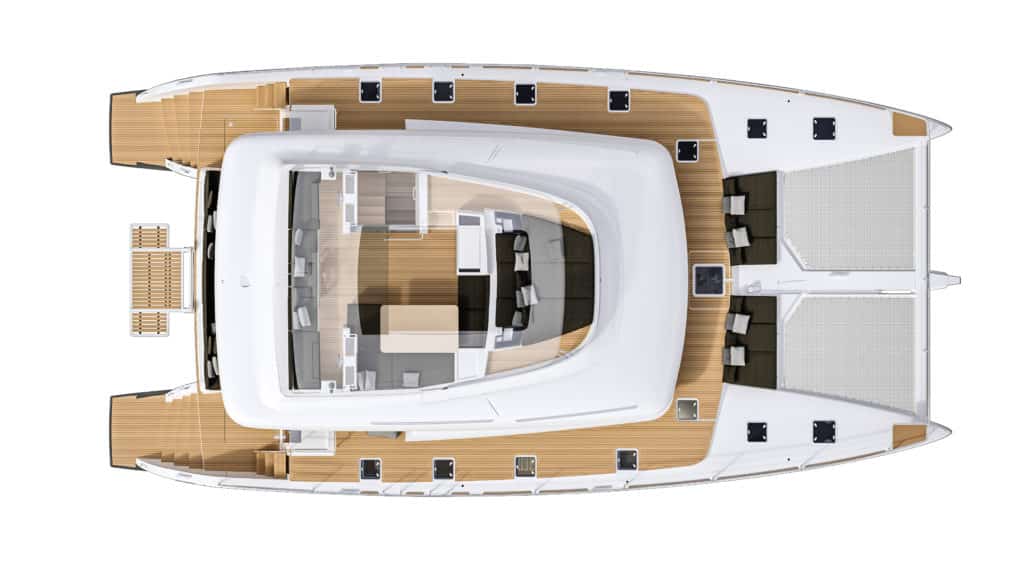
There were five of us aboard, including Lucas Lafourcade, the captain, and Victor Buson, the engineer, who had only recently brought Hull No. 1 of the Lagoon 630 MY across the Atlantic from France on her own bottom — a telling achievement. Yann Masselot, Lagoon’s global director, was also aboard, along with Lana Lohe from the company’s Annapolis, Maryland, office. We spent a quiet night anchored in good holding ground, in a layout that was conducive to privacy and relaxation. This 630 MY was the lateral galley, four-stateroom version, meaning the galley was down in the portside hull along with two of the four staterooms, all with en suite heads.
My hosts had offered me the owners’ stateroom, which was down and aft in the starboard hull. Long and spacious, it was equipped with a glassed-wall shower, double sink vanity, enclosed head and queen-size berth with loads of stowage in the forward part of the cabin. I particularly liked the private entrance to the aft deck, a feature that is shared with the lateral galley in the portside hull.
Most of the other cabins had large berths that, like the one in the master, sat athwartships with the foot of the bed toward the outside of the hull. One exception on Hull No. 1 was the portside central cabin, which was fitted with bunk beds for the captain and engineer. The layout options include a pair of four-cabin versions, one five-cabin version and two six-cabin versions, two of which offer the lateral galley that was on our test 630 MY and three of which offer a central galley in the same space as the salon. In all versions, headroom in the salon and the cabins is 6 feet 9 inches.
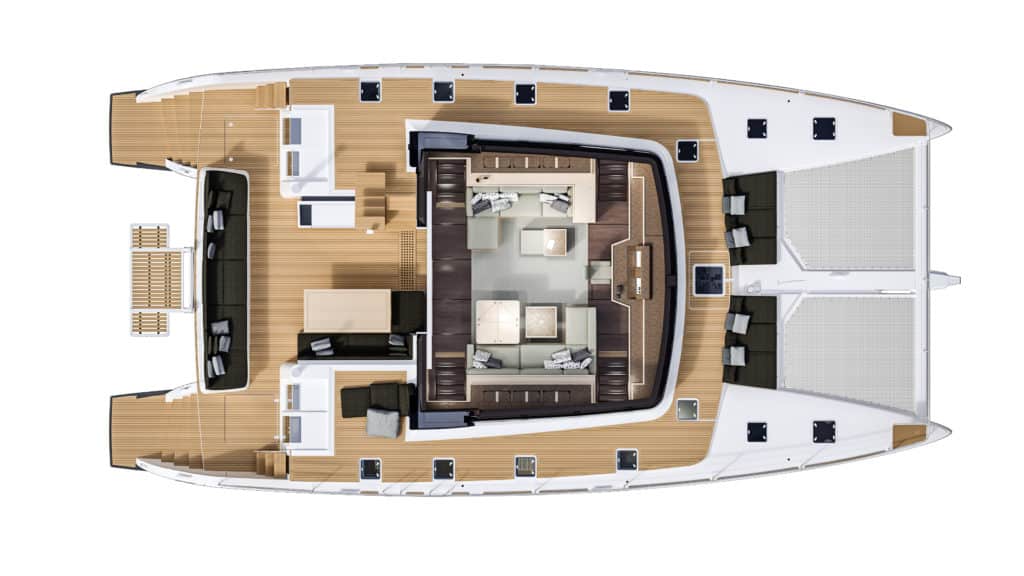
As you might guess by looking at the salon photo, the lateral galley allows this common space to be wide open and generously furnished with seating. Lagoon selected Nauta Design to give all of the accommodations a modern, comfortable look with an elegant finish that rivals those it has created for numerous yachts and homes.
The 630 MY marks Lagoon’s return to the motor yacht sector after an absence due to its growing sailing catamaran business. From the beginning, Lagoon wanted to create an exceptional blue-water passagemaker with accommodations and equipment that made living aboard feel both safe and elegant, and this new model achieves that.
Two Simrad multifunction display screens are at each of the three helm stations — two on the flybridge aft, on either side, and one in the center of the salon forward. The salon station has a joystick instead of a steering wheel, while the flybridge stations are near a seating and sunning area with a folding-leaf dining table to starboard, an outdoor kitchen and bar, and two sun pads — perfect for a crowd or a family getaway. In the hardtop, there is a folding fabric sunroof, allowing the host to optimize or minimize the amount of sun coming through to the flybridge seating and sunning areas.
AS YOU MIGHT GUESS BY LOOKING AT THE SALON, THE LATERAL GALLEY ALLOWS THIS COMMON SPACE TO BE WIDE OPEN AND GENEROUSLY FURNISHED WITH SEATING.
Access to the flybridge is from the port side of the aft deck, up a flight of stairs equipped with stainless-steel handholds. An electrically actuated hatch can close off the flybridge to help keep the aft deck dry during a rainstorm.
It was, by the way, never necessary to close this hatch while we were running in the big waves of the Gulf Stream, because the flybridge is well elevated above the waterline.
The aft deck was our favorite place to dine and hang out, and it came with its own bar housing a refrigerator and ice maker. Lagoon installed teak planking on every weather deck, from the swim platform to the foredeck, for improved footing.
The custom Lagoon RIB tender was stowed on a hydraulic platform, and at anchor with the tender deployed, that platform doubled as a small teak beach for swimmers. It can be lowered just beneath the water for youngsters and others looking for a lift back to the aft deck stairs following their latest swim or snorkeling adventure. Masselot told me that beyond such features, the power cat’s shape and fuel-efficient engines would be key to the yacht’s success.
THE AFT DECK WAS OUR FAVORITE PLACE TO DINE AND HANG OUT, AND IT CAME EQUIPPED WITH ITS OWN BAR HOUSING A REFRIGERATOR AND ICE MAKER.
“Fitted with the optional twin 300-horsepower Volvo Penta D4 diesels, the 630 MY burns only 1.64 gph total at 6 knots, giving a theoretical range of 2,952 nautical miles with standard tankage of 793 gallons,” he said. “Hull No. 1 had an optional 502-gallon tank, giving it transatlantic range.”
Luxury, stability and economy are all hallmarks of Lagoon’s return to luxury motor yachts. If you can take a ride, it will be worth your time.
Lagoon Motor Yachts, 410-280-2368; lagoonmotoryachts.com
| Lagoon 630 MY | Manufacturer Supplied Numbers |
|---|---|
| Overall length | 63’ 11’’ – 19.50 m |
| Waterline length | 61’ 2’’ – 18.65 m |
| Maximum beam | 32’10’’ – 10.00 m |
| Fresh water capacity | 254 US Gal. – 960 l |
| Standard fuel capacity | 793 US Gal. – 3000 l |
| Standard engine power | 2 x 260 HP |
| Optional engine power | 2 x 300 HP |
| Naval architects | VPLP |
| Interior design | Nauta Design |









